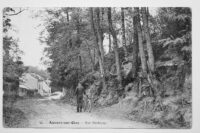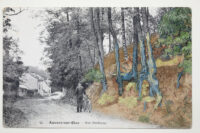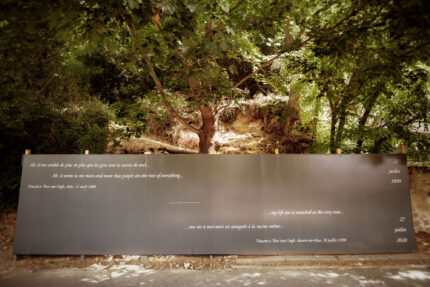 The exact location of Vincent van Gogh’s last painting has been identified thanks to a vintage postcard. On July 27th, 1890, hours before he took the shot to the chest that would kill him two days later, van Gogh painted Tree Roots. He never finished it. His brother Theo’s brother-in-law described it in a letter: “The morning before his death, [Vincent] had painted a sous-bois [forest scene], full of sun and life.”
The exact location of Vincent van Gogh’s last painting has been identified thanks to a vintage postcard. On July 27th, 1890, hours before he took the shot to the chest that would kill him two days later, van Gogh painted Tree Roots. He never finished it. His brother Theo’s brother-in-law described it in a letter: “The morning before his death, [Vincent] had painted a sous-bois [forest scene], full of sun and life.”
The spot was identified by Wouter van der Veen, the scientific director of the Institut van Gogh, a non-profit organization dedicated to the preservation of van Gogh’s room at the Auberge Ravoux and the  landscapes around Auvers-sur-Oise that inspired his last works. The clue that solved the puzzle was a postcard. Titled “Auvers-sur-Oise — Rue Daubigny,” the card features a man walking his bike past a hillside with trees and exposed roots. It was printed from 1900 to 1910, so the photograph was taken at most 10 years after van Gogh’s death.
landscapes around Auvers-sur-Oise that inspired his last works. The clue that solved the puzzle was a postcard. Titled “Auvers-sur-Oise — Rue Daubigny,” the card features a man walking his bike past a hillside with trees and exposed roots. It was printed from 1900 to 1910, so the photograph was taken at most 10 years after van Gogh’s death.
Van der Veen contacted experts at the Van Gogh Museum in Amsterdam  who together with a historical vegetation specialist (extremely cool job) did a comparative study of Tree Roots, the postcard and the hillside as it looks today. They agreed with Van der Veen’s conclusions that this was indeed the site of van Gogh’s last painting.
who together with a historical vegetation specialist (extremely cool job) did a comparative study of Tree Roots, the postcard and the hillside as it looks today. They agreed with Van der Veen’s conclusions that this was indeed the site of van Gogh’s last painting.
Wouter van der Veen[…]:
‘Every element of this mysterious painting can be explained by observation of the post card and the location: the shape of the hillside, the roots, their relation to each other, the composition of the earth and the presence of a steep limestone face. The site is also consistent with Van Gogh’s habit of painting motifs from his immediate surroundings. The sunlight painted by Van Gogh indicates that the last brush strokes were painted towards the end of the afternoon, which provides more information about the course of this dramatic day ending in his suicide.’
Teio Meedendorp (senior researcher at the Van Gogh Museum):
‘In our opinion, the location identified by Van der Veen is highly likely to be the correct one and it is a remarkable discovery. On closer observation, the overgrowth on the post card shows very clear similarities to the shape of the roots on Van Gogh’s painting. That this is his last artwork renders it all the more exceptional, and even dramatic. This area had already been documented by Van Gogh in other paintings. He must often have passed by the location when going to the fields stretching out behind the castle of Auvers, where he painted several times during the last week of his life and where he would take his own life.’
Wouter van der Veen was finally able to scout the site in person some months after his discovery when lockdown ended in France in May. The spot is 500 feet or so from the Auberge Ravoux, easy walking distance for the artist carrying his equipment. The largest tree is still recognizable from the painting.
A wooden barrier has been erected to protect the site. On July 28th, 130 years to the day (minus one) since Vincent’s death, a plaque was installed in Auvers-sur-Oise to commemorate the location where he painted his last masterpiece. Willem van Gogh, Vincent’s great-grandnephew, was in attendance.

Barrier kinda wrecks the place. Remove signage and no one will know the site’s significance, and it’ll be left alone.
I do hope that sign is merely temporary. It hides the artistic beauty of the tree roots completely.
Bookbub is the best. Having 100+ reviews also does wonders for a book, you can try usbookreviews dot com for reviews. 100+ reviews also help with getting accepted with bookbub and other promotion sites.
:I agree. The site should be left unguarded with a small plaque nearby and people in the know will see it. Its what he would have wanted Im sure.